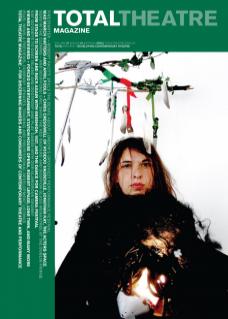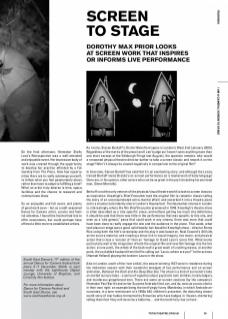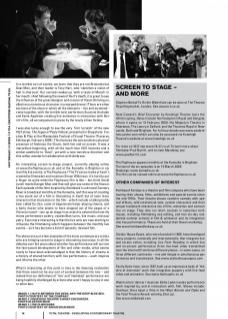As I write, Steven Berkoff’s On the Waterfront opens in London’s West End (January 2009). Regardless of the merits of the piece (and I can’t judge as I haven’t seen anything more than one short excerpt at the Edinburgh Fringe last August), the question remains: why would a renowned physical theatre director bother to take a screen classic and rework it on the stage? Won’t it always be viewed negatively in comparison to the original film?
In interview, Steven Berkoff has said that it’s an everlasting story; and although the Lecoq-trained Berkoff views Brando’s on-screen performance as ‘a masterwork of body language’ there are, in his opinion, other actors who can be as great in the part (including his own lead man, Simon Merrells).
Berkoff is not the only veteran of the physical/visual theatre world to look to screen classics as inspiration. Kneehigh’s Brief Encounter took the original film (a romantic classic telling the story of an unconsummated extra-marital affair) and reworked it into a theatre piece set in a cinema (coincidently also in London’s Haymarket). The Haymarket cinema in London is, interestingly, where the film Brief Encounter premiered in 1946. Kneehigh’s theatre show is often described as a ‘site specific’ piece, and without getting too much into definitions, it should be said that there was little in the performance that was specific to this site, and even as a ‘site generic’ piece that could work in any cinema, there was more that could have been done to really engage the site and the audience in the piece. That aside, what took place on stage was a good, solid bawdy-but-beautiful Kneehigh show – director Emma Rice using both the film’s screenplay and the play it was based on, Noel Coward’s Still Life, as her source material, and creating a show rich in visual imagery, live music, and physical action that is less a ‘version of’ than an ‘homage to’ David Lean’s iconic film. What works particularly well is the integration of both the original film and new film footage into the live action: at one point, the whole of the back wall a great wash of crashing waves; at another point, the cuckolded husband from the film calling out ‘Laura, where are you?’ to the actress (Hannah Yelland) playing the lovelorn Laura in the show.
Also in London, south of the river at BAC, the award-winning 1927 were in residence during the midwinter season with their wonderful amalgam of live performance and on-screen animation, Between the Devil and the Deep Blue Sea. The show is a kind of surrealist’s take on morbid nursery tales – a series of vignettes about psychotic twin children, lonely lodgers, and murderous gingerbread men. There are some on-screen sections (by the company’s filmmaker Paul Barritt and writer Suzanne Andrade) that can, and do, exist as screen shorts in their own right: an example being the terrifyingly funny Manderlay, in which Andrade annunciates, in a tone reminiscent of a 1950s BBC children’s presenter, the disturbing dreamworld story of star babies tormented by Brownies who have badges in ‘illusion-shattering’ telling them that ‘they will never be a ballerina… and the tooth fairy has no face’.
In a terrible turn of events, we learn that they are not Brownies but Goat Men, and their leader is Tony Hart, who ‘sketches a vision of hell in charcoal’. Our narrator wakes up ‘with a taste of Morph’ in her mouth. (And following the news of Hart’s death, it is great to see the influence of the great designer and creator of Vision On living on, albeit as a monstrous character in a warped dream.) There are other sections of the show in which all the elements – live and screened – come together, with the terrible twin performers Suzanne Andrade and Esme Appleton creating live animation in interaction with Barritt’s film, all accompanied on piano by the lovely Lillian Henley.
I was also lucky enough to see the very first ‘scratch’ of the new 1927 show, The Fugue of Pazzy Villycar, presented in Snapshots: Creation & Play at the Manipulate Festival of Visual Theatre (Traverse, Edinburgh, February 2009). This features the extraordinary physical presence of Ambrose the Clown, both live and on screen. It was a marvellous beginning, with all the much-love 1927 features and a similar aesthetic to ‘Devil’, yet with a new narrative direction and this rather wonderful collaboration with Ambrose.
An interesting screen-to-stage project, currently playing online at www.theflophouse.co.uk and at the Komedia in Brighton in six monthly live events, is The Flophouse (‘The TV series inside yr head’), created by filmmaker and musician Simon Wilkinson. It’s hard to put a finger on quite what the Flophouse film is like – but think David Lynch meets Danger Man and that will give you some of the flavour. Each episode of the film (inspired by Steinbeck’s cult novel Cannery Row) is broadcast monthly at the Komedia, and this way of creating a live event out of a film is interesting in itself; but of even more interest is that characters in the film – which include a talking teddy bear called Su-Zan, a pair of degenerate banjo-playing clowns, and a batty doctor who seems to have stepped out of the pages of a Victorian novel – turn up on stage in an anarchic cabaret that merrily mixes performance poetry, vaudevillian turns, live music, and puppetry. Even more interesting is that the live acts are now starting to influence the filmmaking which happens between the monthly live events – so it has become a kind of episodic, devised film.
The above are just a few examples of the many contemporary artists who are bringing screen to stage in interesting new ways. In all the debates over the years about whether live performance will survive the fast-paced development of film and other media, what seems rarely to have been acknowledged is that the history of cinema is a history of shared territory with live performance – each inspires and informs the other.
What’s interesting at this point in time is the dawning realisation that there need not be any sort of contest between the two – and indeed that our definitions of ‘live’ and ‘mediated’ performance are being healthily challenged by artists who aren’t happy to stay in one or other box.
Screen to stage – and more
Stephen Berkoff’s On the Waterfront can be seen at The Theatre Royal Haymarket, London. See www.trh.co.uk
Noel Coward’s Brief Encounter by Kneehigh Theatre tours the UK this spring. Dates include: Northampton’s Royal and Dengate, where it opens on 13 February 2009; His Majesty’s Theatre in Aberdeen; The Lowry in Salford; and the Theatres Royal in Newcastle, Bath and Brighton. For full tour details see www.seebriefencounter.com which can also be accessed via Kneehigh Theatre’s website at www.kneehigh.co.uk
For more on 1927 see www.19-27.co.uk To learn more about filmmaker Paul Barritt, and to view Mandalay, see www.paulbarritt.com
The Flophouse appears monthly at the Komedia in Brighton. The last of the six episodes is on 14 March 2009. Bookings: www.komedia.co.uk The film can be viewed online at www.theflophouse.co.uk
Other companies of interest
Forkbeard Fantasy is a theatre and film company who have been touring their shows, films, exhibitions and special events since the mid-1970s. Their theatre shows combine comedy with special effects, wild mechanical sets, outsize characters and their unique trademark interactive mix of film, animation and cartoon live on stage. They also run short courses in numerous techniques, including filmmaking and editing, and two six-day residential summer schools in film & animation and its integration into live performance. These are held at their Devon workshop. See www.forkbeardfantasy.co.uk
Station House Opera, who were founded in 1980, have developed many projects, nationally and internationally, that integrate live and screen action, including Live From Paradise, in which live and on-screen performance (from live-feed video transmitted over the internet) from three different places – in some cases, on three different continents – mix and mingle in simultaneous performance and transmission. See www.stationhouseopera.com
Faulty Optic have, since 1987, built up an impressive body of ‘theatre of animation’ work that integrates puppetry with live-feed video and animation. See www.faultyoptic.co.uk
Welsh artist / dancer / musician Eddie Ladd creates performance work inspired by, and in interaction with, film. Shows include: Scarface; Once Upon a Time in the West; Bonnie and Clyde and the Total Theatre Award-winning Club Luz. See www.eddieladd.com


